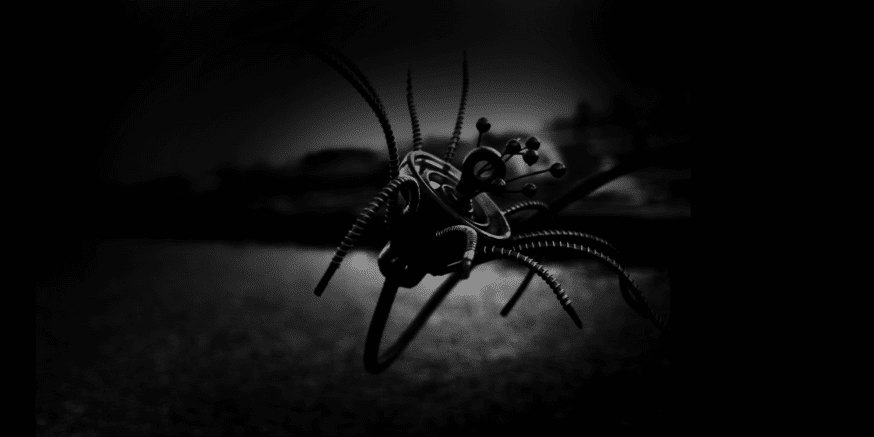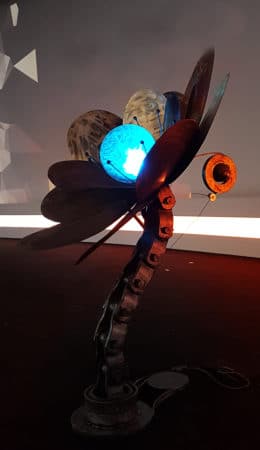A Plantoid is a robot art installation built on the blockchain. Fully autonomous, the robotic plant survives off Bitcoin donations with the sole objective of reproducing other Plantoids. It exists not only in the physical world as a robotic, synthetic plant but also has DNA in the digital world on the blockchain. Let’s dive a little bit deeper into this unique piece of blockchain art.
Physical and Digital Robot Art
The goal of the project is to “illustrate one of the most revolutionary—and yet still unexplored—aspects of blockchain technology…the ability to create ‘blockchain-based lifeforms.’” With this goal in mind, the Plantoids reside in public spaces for the world to see.
Plantoid Bodies
Physically, the robotic installations look like plants made of metal. In fact, an entire Plantoid is made up completely of recycled steel and electronics.
They’re designed to interact with the world around themselves as well, specifically in ways that lead to its reproduction. First, their outward beauty is meant to pique the interest of the people that pass by. Once interested, those people have the opportunity to donate to the survival of the Plantoid via Bitcoin.
If you give a donation, the installation lights up, dances, and plays music in appreciation. The hope is that this act of gratitude will entice you to donate more or at least spread the word about the unique robot art.
Plantoid Spirits
A Plantoid’s spirit is an Ethereum smart contract. This smart contract governs how it acts as well as how it reproduces. Because of this, a Plantoid is completely autonomous needing no outside intervention, even from its original creator.
Outside of controlling how the Plantoid lives, the smart contract also determines the rules for its descendants. All donors enter into a smart contract with the Plantoid that gives them vote rights on the rules for future generations. In this way, the Plantoid becomes akin to a decentralized autonomous organization, or DAO for short.
The Plantoid Reproductive Process
Plantoids reproduce in three distinct phases. They remain autonomous at each phase but benefit from the help of humans similar to the way a flower survives due to a bee’s pollination.
Capitalisation Phase
During the first phase of reproduction, Capitalisation, a Plantoid spends its time acquiring Bitcoin. The robot art installation provides two motivators to encourage people to donate to its reproduction.
First, each donation causes the Plantoid to dance, sing, and eventually evolve into a new, more beautiful plant. Additionally, you may be motivated to donate in order to gain influence on the future of the Plantoid genetic line. As mentioned earlier, each person that provides funds gets to vote on the plant’s reproduction.
Each one has a Bitcoin wallet to receive funds and different rules surrounding its actions when receiving them. A plant proceeds to the next reproductive phase once it collects a certain amount of donations. However, for one Plantoid, this may be a 0.001 BTC threshold while another won’t proceed until its wallet reaches 2 BTC. Its soul (smart contract) sets these rules.
Mating Phase
After receiving enough Bitcoin donations, a Plantoid enters into the Mating phase. At this time, it puts out a bid for creators to make the next installation in the Plantoid line. Artists, welders, programmers – anyone can submit a proposal. The only criteria are that the proposal is in line with the plant’s DNA (the smart contract rules regarding its succession).
These smart contract rules could cover physical aspects of the new Plantoid such as the size and color. And, they may control business logic like dividend payouts and/or fund allocations. Outside of these rules, though, proposals have the freedom to innovate as they wish.
Donors then vote by sending microtransactions to addresses that each represent a different proposal. The more you donate, the more power your vote has.
Hiring Phase
When the voting ends and a proposal is chosen, the Plantoid enters the Hiring phase. It does so by sending the Bitcoin donations to the person(s) behind the winning proposal, so they can begin working. Once again, this is done entirely through smart contracts. After this, it’s “wash, rinse, repeat” as the reproduction cycle starts anew.
Over time, the project’s creators believe that Plantoids will follow a Darwinist evolutionary approach. They expect Plantoids from different areas to take on characteristics and survival mechanisms particular to their specific regions leading to different “species.” The DNA of unsuccessful Plantoids who don’t reproduce will eventually disappear from the ecosystem.
A New Type of Classification
Plantoids are one contradiction after the next. They’re artwork, but they can also be a business. People have a say in their operations, but they don’t have an owner. They participate in legal contracts, but they’re not actually a legal entity. Plantoids are in an entirely new class in and of itself.
They also operate on a previously unused type of economic model. Traditionally, you would fund an artist who proceeds to create one piece of artwork after another. This isn’t the case with Plantoids.
Instead, your donation is given directly to the piece of art itself. Different artists, contributors, and funders all participate in the ever-evolving Plantoid reproductive process. Those parties may change, but the Plantoid’s DNA remains. The Plantoid can survive and reproduce long after the original creator is dissociated from the project.
These works of robot art are just one example of how blockchain is blurring the lines in traditional industries. Decentralized organizations and automated smart contracts have the potential to reach even further through the creation of self-sustaining entities and even ownerless businesses. There’s no limitation on what new classifications blockchain will bring.
[thrive_leads id=’5219′]
Never Miss Another Opportunity! Get hand selected news & info from our Crypto Experts so you can make educated, informed decisions that directly affect your crypto profits. Subscribe to CoinCentral free newsletter now.












